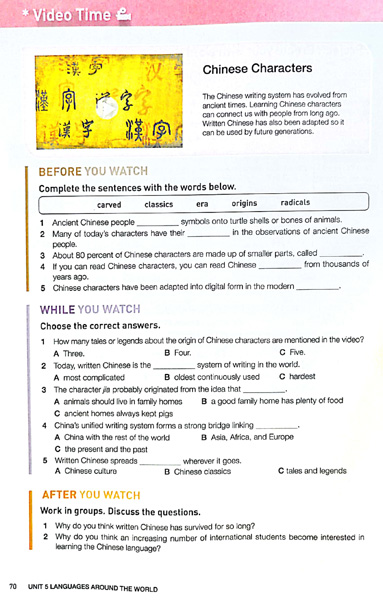教材文本:

视频文本:
Chinese Characters
The history of Chinese characters dates back to ancient times, with a history of at least several thousand years. There are many tales and legends about the origin of hanzi, Chinese characters: there is Cangjie, the legendary inventor of the Chinese characters; the ancient practice of knot-tying; the eight trigrams; and ancient painting legends, to name a few.
It is generally agreed that hanzi began as simple pictures, images that the ancient Chinese people drew, painted or carved to describe nature or their lives. Other ancient cultures developed picture-based writing systems as well, such as the hieroglyphs of ancient Egypt or the script of the ancient Mayan civilisation. Hanzi, however, is the only one of these ancient writing systems to survive. Today, the Chinese characters are the oldest continuously used system of writing in the world.
Researchers generally agree that the oldest symbols recognisable as Chinese characters are those found on ancient oracle bones. These 3000-year-old symbols, known as jiaguwen, were carved on turtle shells or bones of animals. The jiaguwen can give all of us in the modern era insight into how ancient Chinese saw the world around them and into their great creativity in expressing their observations.
Take, for example, the modern character jia, meaning home or family. The jiaguwen character looks like a house with a nice pig inside, originating from the ancient idea that a good family home has plenty of food. Over thousands of years, this hanzi evolved into a variety of different forms, but finally developed in a more stable manner after the unification of China under Emperor Qinshihuang.
When you first look at Chinese characters, you will most likely feel that they are very complicated. However, if you know just a little about how these characters are formed, you will find that they are not nearly as difficult as they seem. About 80% of Chinese characters are composed of smaller parts, known as radicals, which are combined in many different ways to form tens of thousands of hanzi. Fortunately, you need to know only about two or three thousand characters for use in daily life.
Chinese characters and Chinese culture are inseparably linked. China's unified writing system forms a strong bridge, linking the Chinese people and culture of the present with those of the past. No matter when or where you live, if you can read Chinese, you can read ancient Chinese classics. It is truly an amazing thing to be able to hear the thoughts and observations of people from thousands of years ago.
As China takes its place in the international community, the Chinese writing system has spread to other countries. Today, many international students are studying Chinese, both the spoken and written language, and are coming to appreciate China's fascinating culture. And as China's culture and society have continued to develop, the amazingly versatile Chinese characters (hanzi) have been adapted for use in digital format on computers and other devices. And so written Chinese lives on, spreading Chinese culture wherever it goes.
